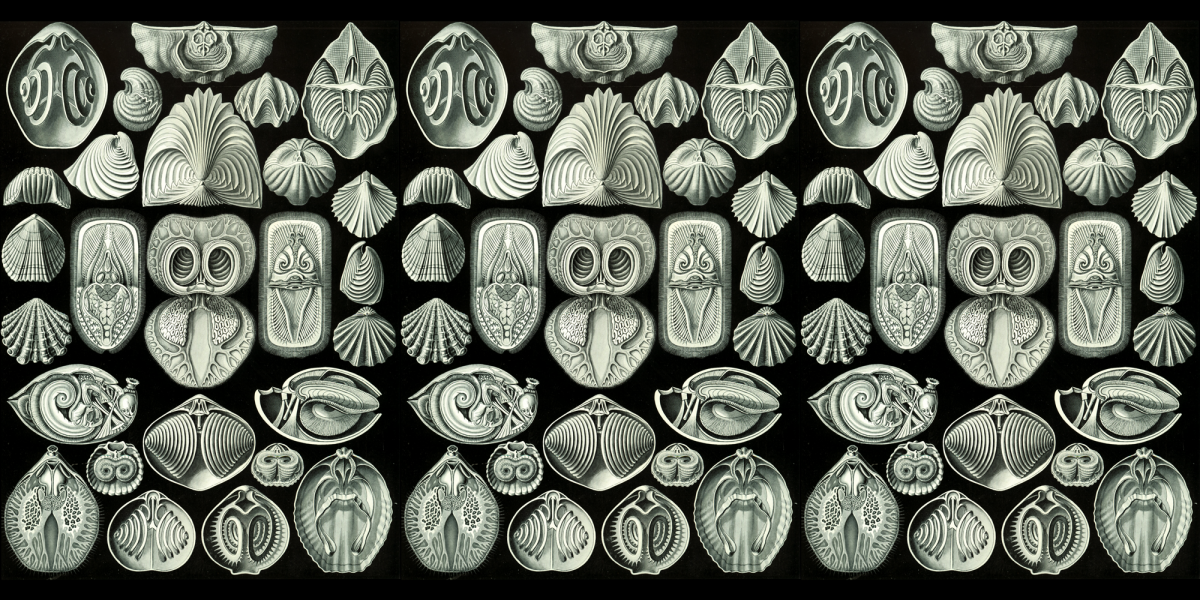Chapter contents:
1.Brachiopoda
–– 1.1 Brachiopod Classification ←
–– 1.2 Brachiopods vs. Bivalves
–– 1.3 Brachiopod Paleoecology
–– 1.4 Brachiopod Preservation
Above image: Kunstformen der Natur (1904), plate 97: Spirobranchia by Ernst Haeckel; source: Wikimedia Commons (Public Domain).
Overview
With very few living representatives, brachiopod classification has primarily come from a paleontological perspective, with substantial consideration given to the morphology of the shell. Traditionally, brachiopods have been separated into two major groups: the Inarticulates (brachiopods with phosphatic shells) and Articulates (everything else). However, recent advances in molecular phylogenetics has forced researchers to revamp their classification scheme, which now recognizes three subphyla of Brachipoda: Linguliformea, Rhynchonelliformea, and Craniiformea.
Traditional classification: inarticulates vs. articulates
Inarticulates: shells lack defined hinges and are made of calcium phosphate (phosphatic). Example: Order Lingulida.
Articlulates: shells with articulated hinges (with teeth and sockets) and made of calcium carbonate. Examples: all brachiopods other than Lingulida.

Left: Inarticulate lingulid brachiopod (PRI 76882) Right: Articulate spiriferid brachiopod (PRI 70767). Image by Jaleigh Q. Pier is licensed under a Creative Commons Attribution-ShareAlike 4.0 International License.
Modern classification: Subphyla Linguliformea, Rhynchonelliformea, and Craniiformea
Linguliformea: organo-phosphatic shells, no teeth or sockets along hinge, pedicle present. Examples: Order Lingulida.
Craniiformea: calcium carbonate shells, no teeth or sockets along hinge, pedicle absent. Examples: Order Craniida.
Rhynchonelliformea: calcium carbonate shells, both teeth and sockets along hinge, pedicle sometimes present. Examples: Order Strophomenida, Rhynchonellida, Spiriferida etc.
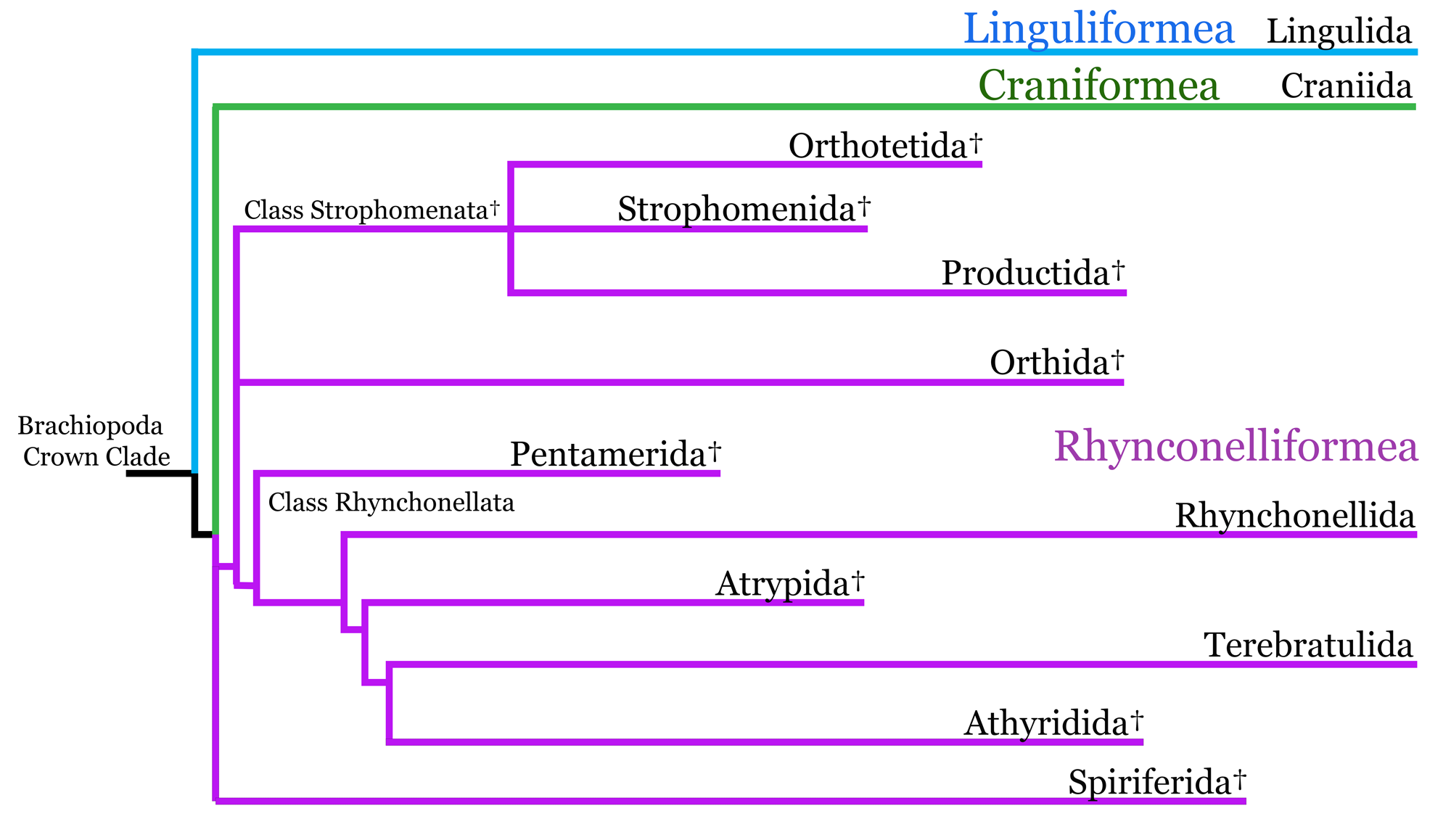
Phylogeny of major brachiopod orders. † indicates an extinct group. Image by Jaleigh Q. Pier, adapted from Figure 2 of (Carlson 2016), is licensed under a Creative Commons Attribution-ShareAlike 4.0 International License.
Important Classification Terms
Brachiopods come in all shapes and sizes. Here are a few common shapes:
- Biconvex: both valves are rounded (convex)
- Plano-convex: brachial valve is flat, while the pedicle valve is rounded (convex)
- Concavo-convex: both valves are cup-shaped and the brachial valve fits inside the pedicle valve
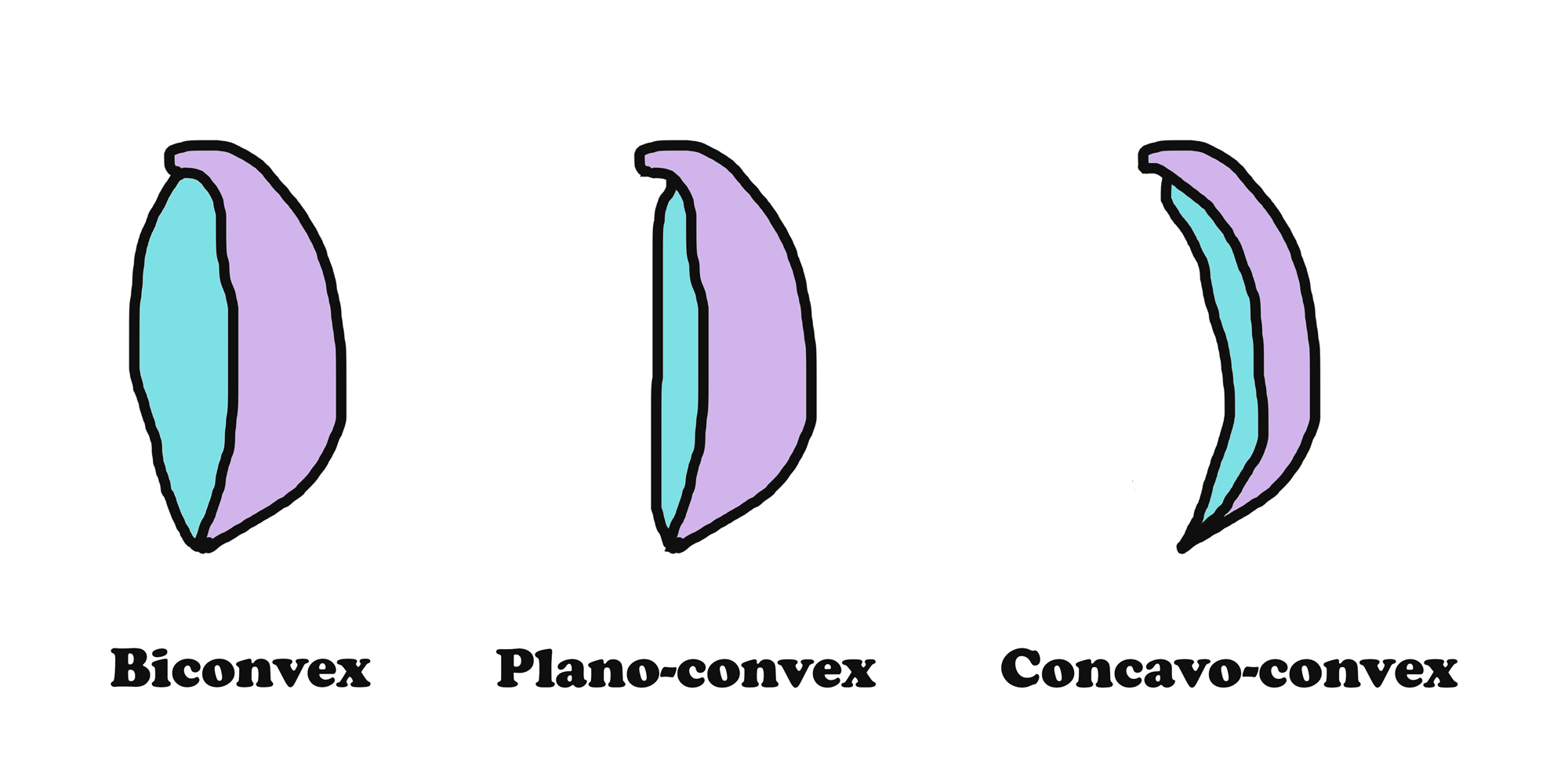
Schematic of brachiopod shell shapes. Blue represents the brachial valve while purple represents the pedicle valve. Image by Jaleigh Q. Pier is licensed under a Creative Commons Attribution-ShareAlike 4.0 International License.
Classification also relies heavily on the shape of the hinge line. There are two main categories:
- Strophic: straight hinges
- Astrophic: curved hinges
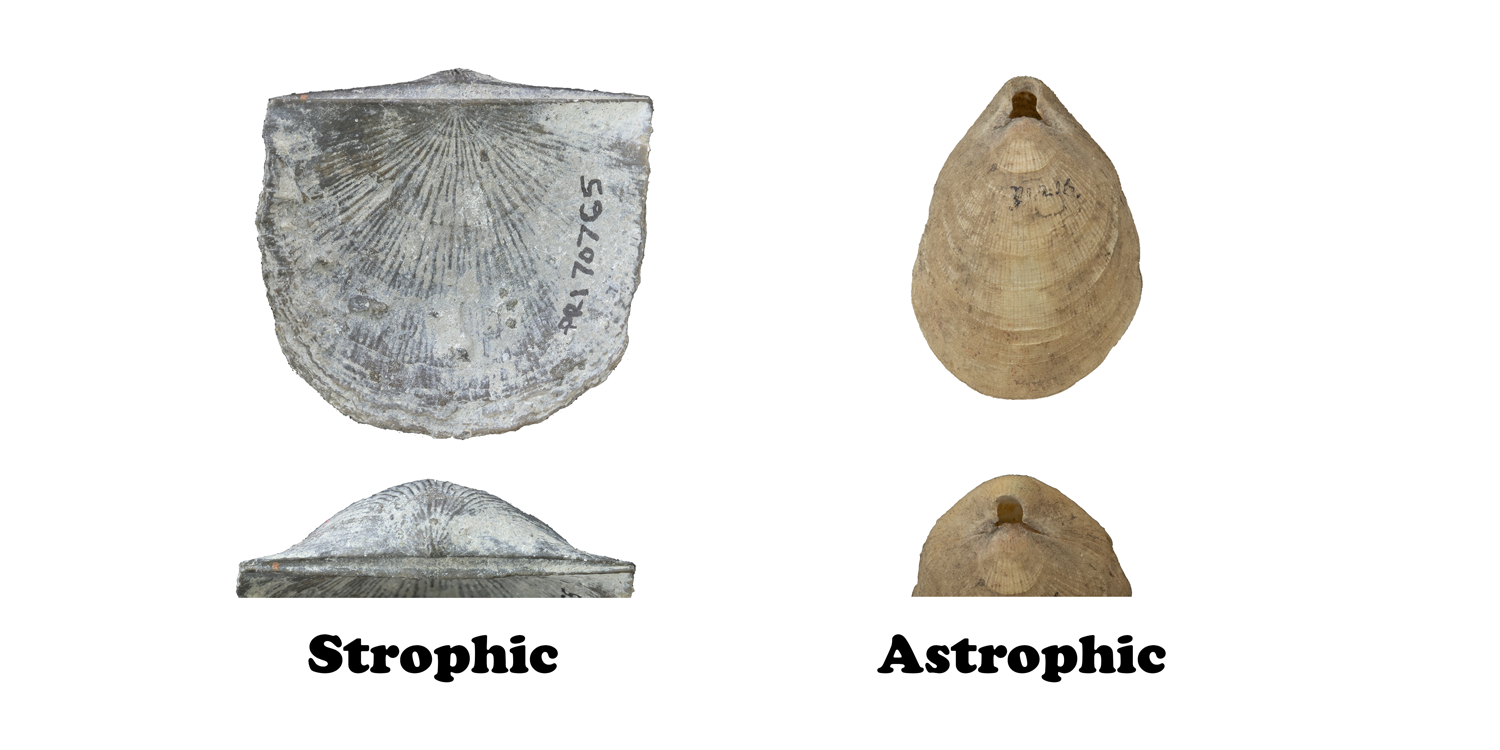
Strophic (straight) hinge lines vs. astrophic (curved) hinge lines. Image by Jaleigh Q. Pier is licensed under a Creative Commons Attribution-ShareAlike 4.0 International License.
Linguliformea
Order Lingulida (Early Cambrian to Recent)
Unlike most brachiopods, lingulid shells are composed of calcium phosphate. Lingulate brachiopods have a well-developed pedicle and complex muscles to aid in burrowing into soft sediments. Lingulids create a vertical burrow that can be 10x the length of their shell.
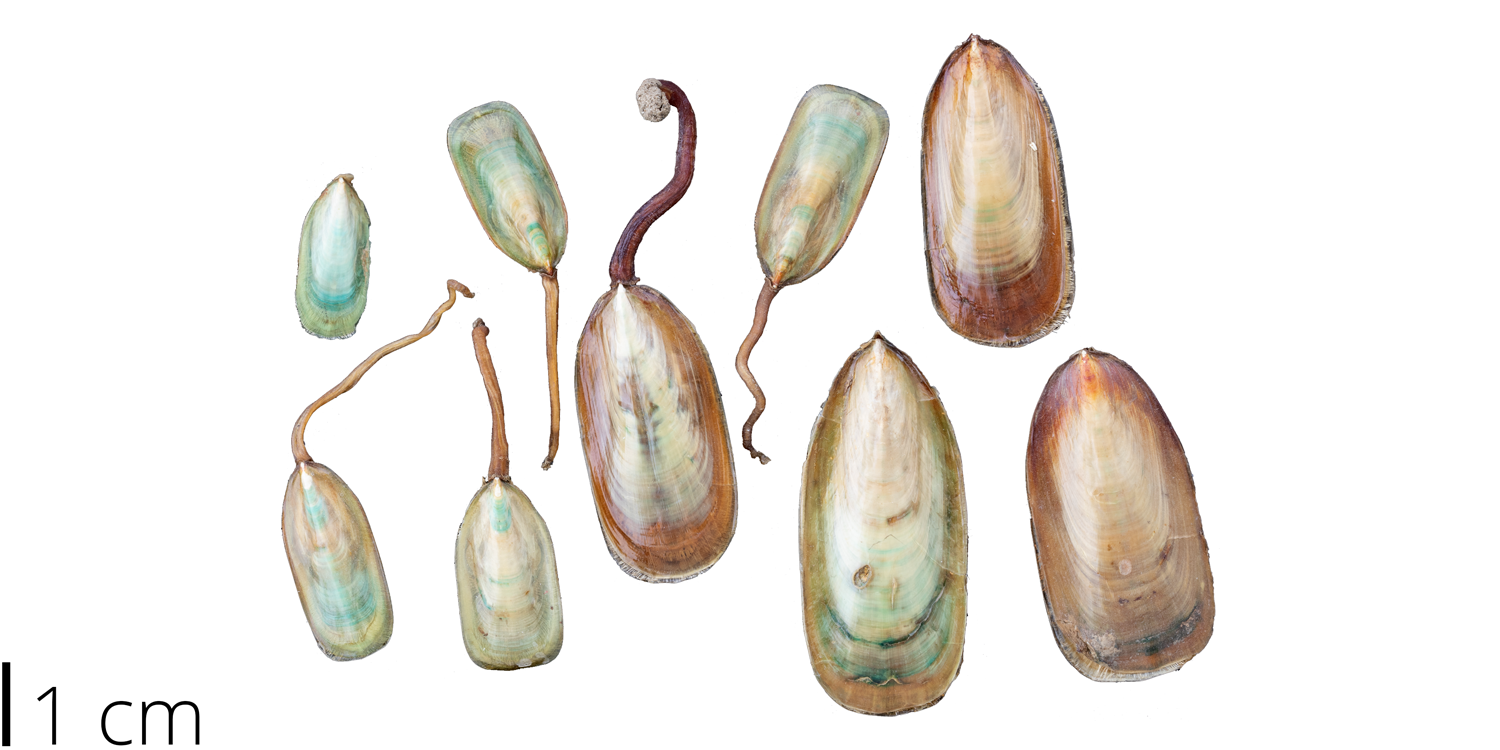
Recent specimen of the brachiopod Lingula anatina from the Phillipines (PRI 76882). Specimen is from the collections of the Paleontological Research Institution, Ithaca, New York.
Recent specimen of the brachiopod Lingula anatina from the Phillipines (PRI 76882). Specimen is from the collections of the Paleontological Research Institution, Ithaca, New York. Longest dimension of specimen is approximately 6 cm.
The shells of lingulids are held together only by the force of their muscles instead of teeth and sockets along a hinge line (as seen in Rhynchonelliform brachiopods). Because of this, they can move their valves apart in a scissor-like motion, which helps them burrow into soft sediments. Watch how this works:
Source: "The Lingula genome provides insights into brachiopod evolution and the origin of phosphate biomineralization" by the Okinawa Institute of Science and Technology (OIST)
Craniiformea
Order Craniida (Ordovician to Recent)
Craniid brachiopods are circular to subcircular in shape. Their dorsal valve is calcified and they tend to encrust onto hard surfaces including other brachiopod shells.

Isocrania costata from the Upper Maastrichtian (Upper Cretaceous), Maastricht, The Netherlands. Image by "Wilson44691" (Wikimedia Commons; Creative Commons CC0 1.0 Universal Public Domain Dedication).

Petrocrania sp. brachiopods on a strophomenid brachiopod from the Upper Ordovician of southeastern Indiana. Image by Mark A. Wilson (Wikimedia Commons; Creative Commons CC0 1.0 Universal Public Domain Dedication).
Rhynconelliformea
Order Athyridida (Ordovician to Jurassic)
Athyrids closely resemble smooth-shelled atrypids but have a slightly more complex spiral brachidium and retain their pedicle after maturation.
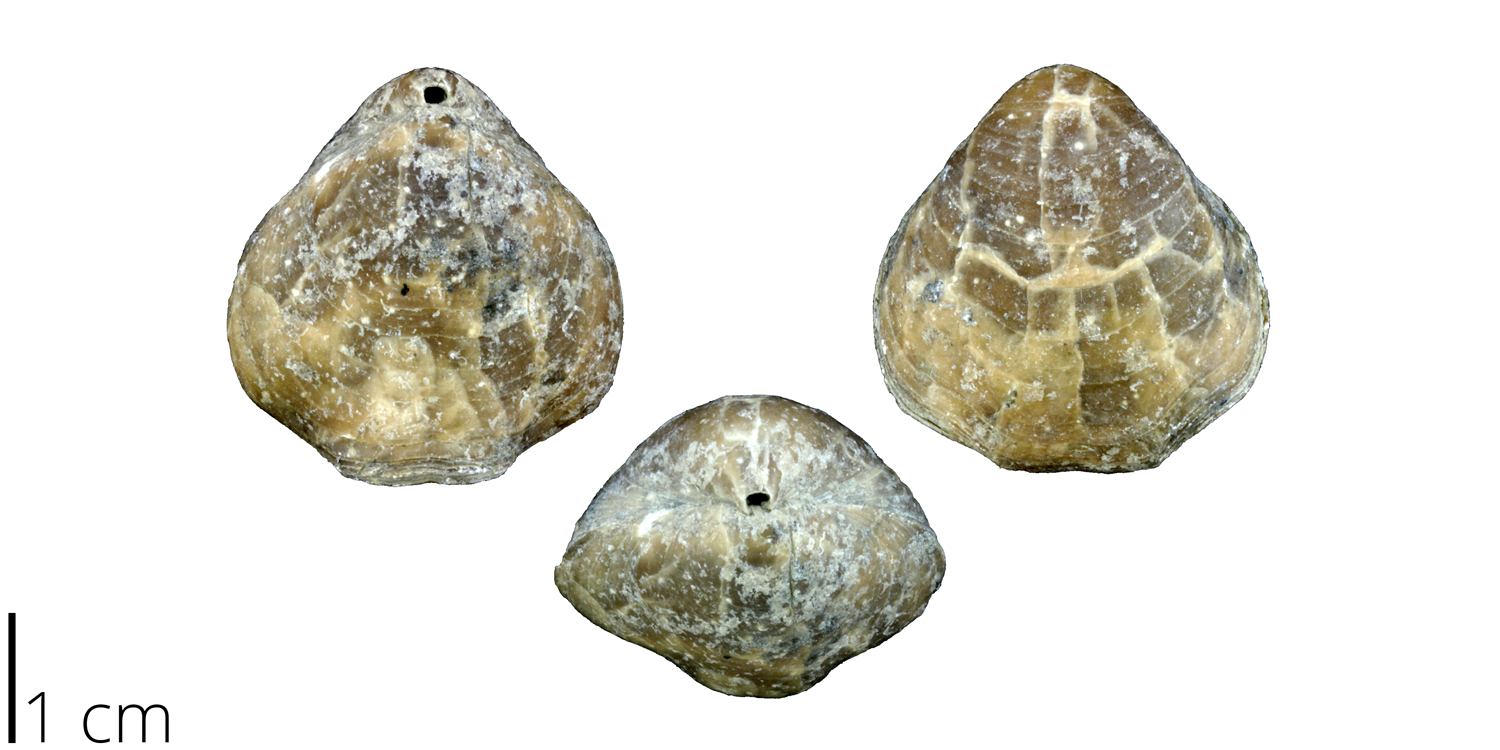
Fossil brachiopod specimen of Composita subtilita from the Pennsylvanian of Nebraska (PRI 76919). Specimen is from the collections of the Paleontological Research Institution, Ithaca, New York.
Fossil specimen of the brachiopod Athyris spiriferoides from the Devonian Ludlowville Formation of Erie County, New York (PRI 44050). Specimen is from the collections of the Paleontological Research Institution, Ithaca, New York.
Order Atrypida (Ordovician to Devonian)
Juvenile atrypids possess a pedicle, which is lost during maturation. They were among the first brachiopods to evolve a spiral-shaped lophophore brachidium. Known to be a tropical group, they were common at the beginning of the Paleozoic, but were wiped out by the Late Devonian Frasnian-Famennian extinction.
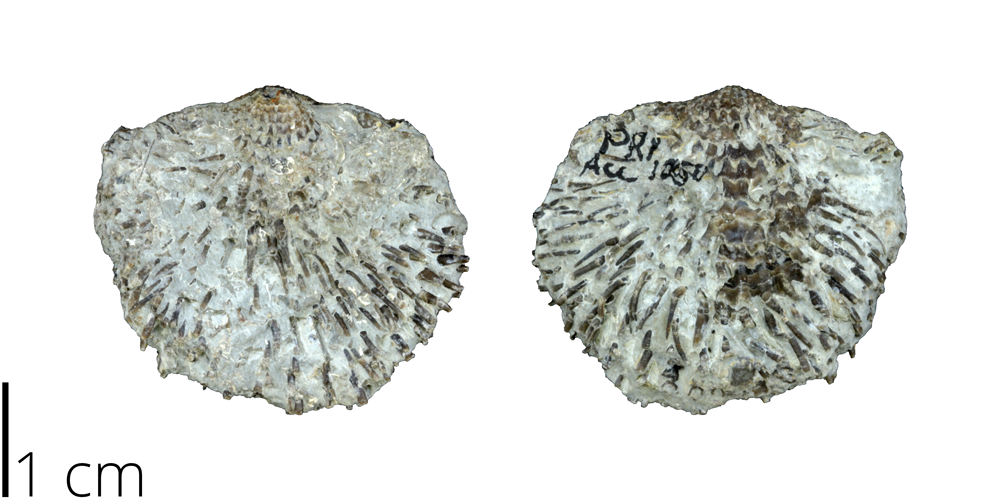
Fossil brachiopod specimen of Atrypa spinosa from the Devonian of New York (PRI 76887). Specimen is from the collections of the Paleontological Research Institution, Ithaca, New York.
Fossil specimen of the brachiopod Spinatrypa spinosa from the Devonian Hamilton Group of Erie County, New York (PRI 70769). Specimen is from the collections of the Paleontological Research Institution, Ithaca, New York. Diameter of specimen is approximately 4 cm.
Order Orthida (Cambrian to Permian)
Orthids were some of the earliest rhynchonelliform brachiopods to diversify. Distinguishing characteristics include a strophic hinge line and shell that is typically ornamented with strong ribbing.
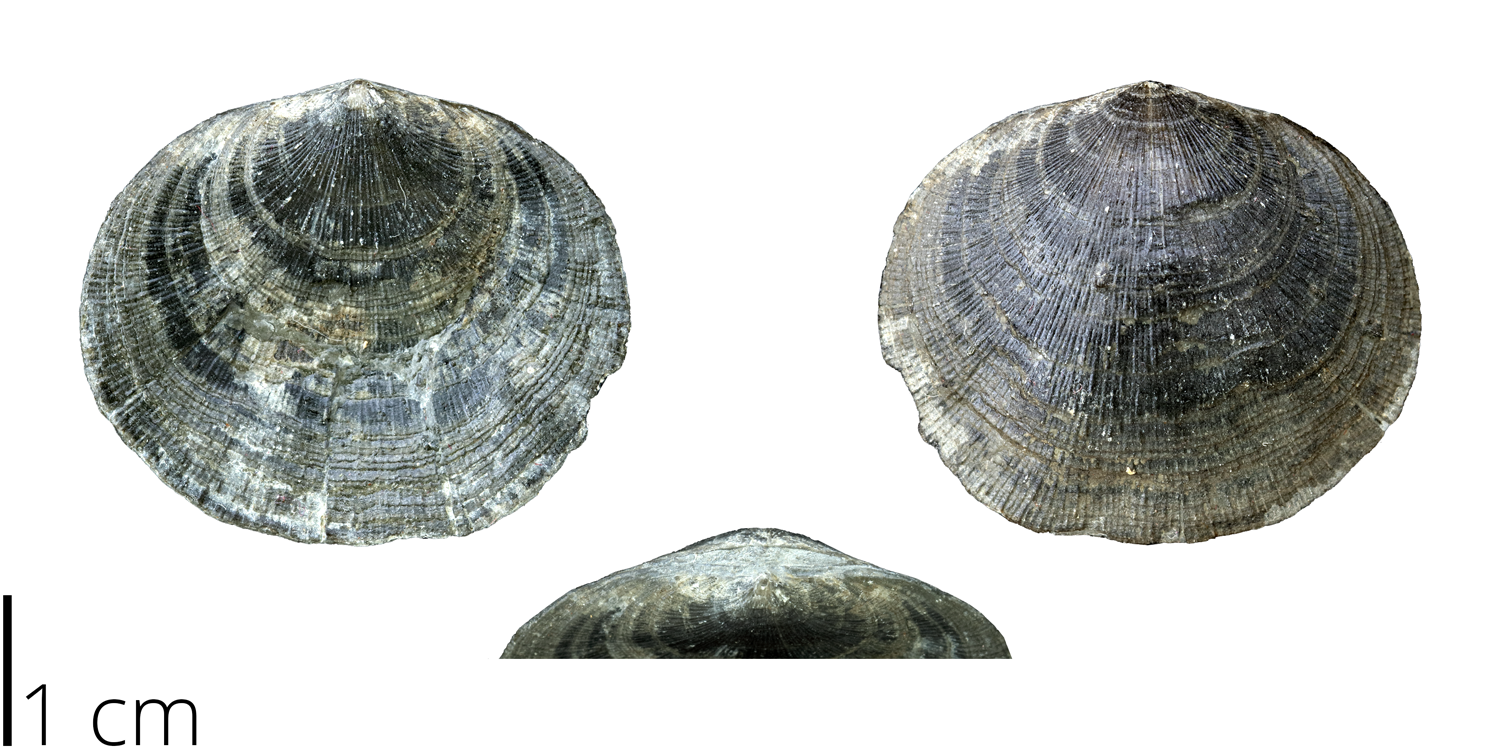
Rhipidomella vanuxemi from the Devonian of New York (PRI 76890). Specimen is from the collections of the Paleontological Research Institution, Ithaca, New York.
Fossil specimen of the brachiopod Hebertella occidentalis from the Ordovician McMillan formation of Brown County, Ohio (PRI 70759). Specimen is from the collections of the Paleontological Research Institution, Ithaca, New York. Longest dimension of specimen is approximately 4.5 cm.
Order Pentamerida (Cambrian to Devonian)
Pentamerids are aptly named for the five-sided (pentagonal) shape of their shells. In contrast with most brachiopods, pentamerids have their fold on the pedicle valve with a corresponding sulcus on the brachial valve.
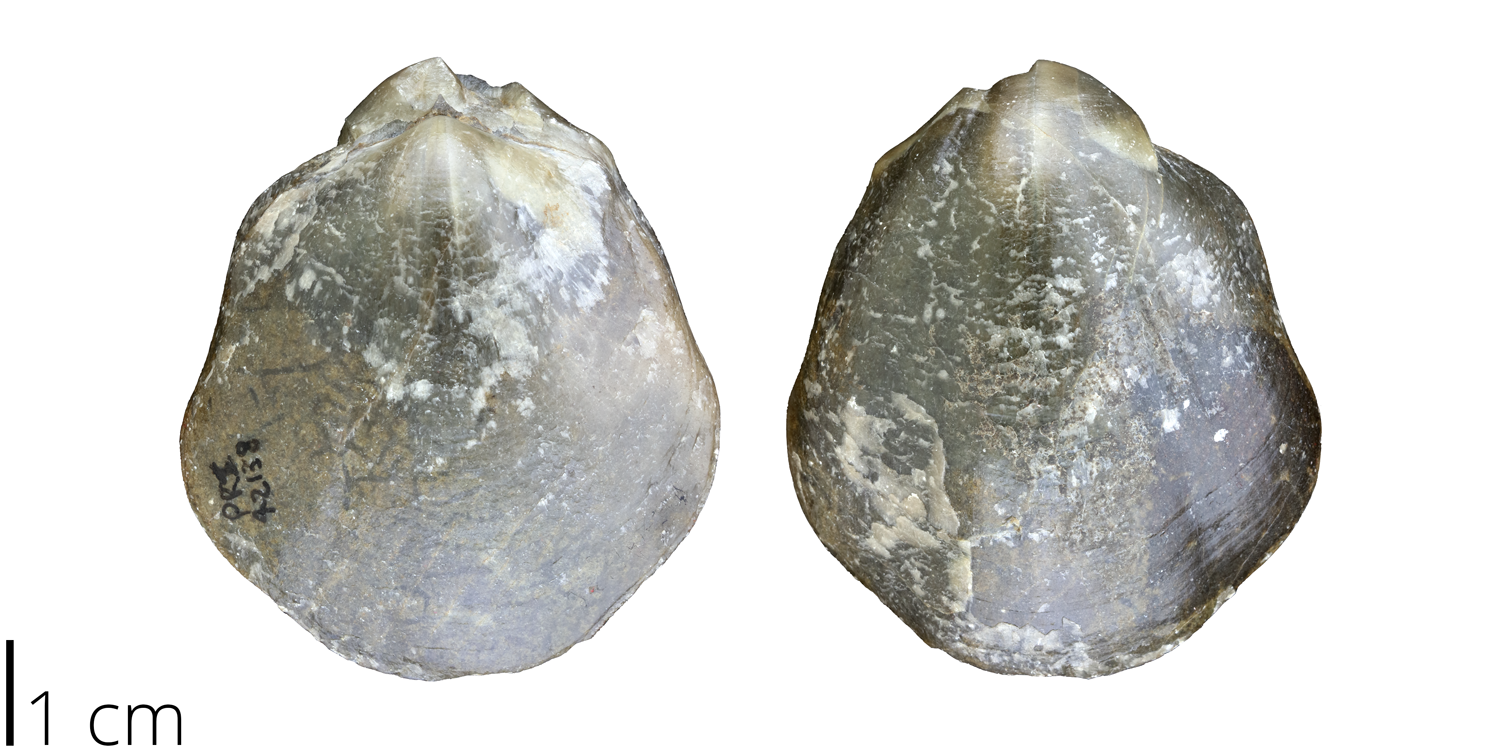
Fossil brachiopod specimen of Pentamerus oblongus from the Middle Silurian Clinton Formation of New York (PRI 42138). Specimen is from the collections of the Paleontological Research Institution, Ithaca, New York.
Fossil brachiopod specimen of Pentamerus oblongus from the Middle Silurian Clinton Formation of New York (PRI 42138). Specimen is from the collections of the Paleontological Research Institution, Ithaca, New York. Longest dimension of specimen is approximately 6 cm. Model by Jaleigh Pier.
Order Productida (Ordovician to Permian)
Productids are best known for their spine-covered shells. Spines functioned as protection and acted as anchors when living on soft substrates, although some also cemented themselves to harder substrates.
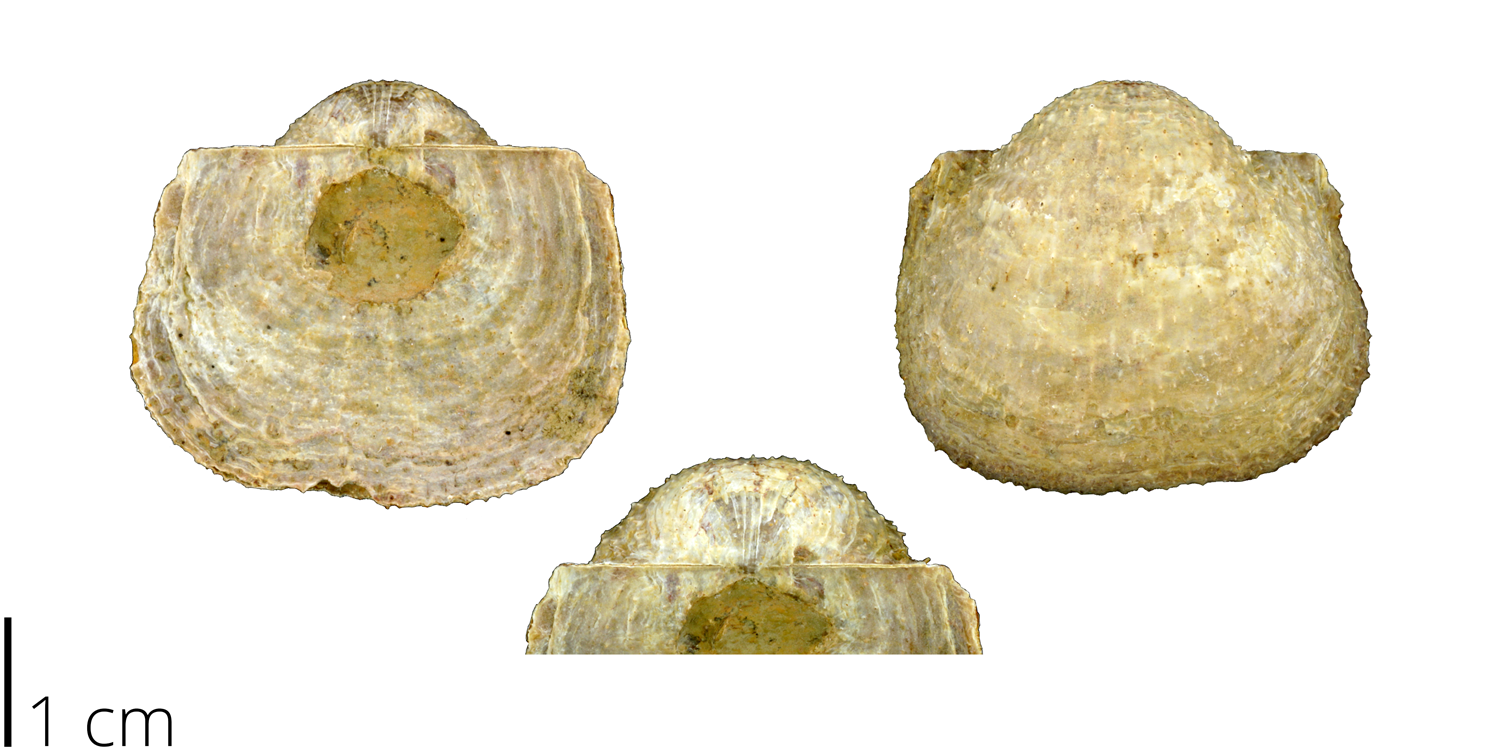
Fossil brachiopod specimen of Pulchratia symmetrica from the Pennsylvanian of Oklahoma (PRI 76915). Specimen is from the collections of the Paleontological Research Institution, Ithaca, New York.
Fossil specimen of a productid brachiopod replaced by quartz from the Permian Glass Mountains of southwest Texas (PRI 76879). From the collections of the Paleontological Research Institution. The longest dimension is 4 cm in length.
Order Rhynchonellida (Ordovician to Recent)
Strong ribbing, plication of zig-zag shapes, and a strong fold/sulcus are characteristic of the rhynchonellids. This group lacks a brachidium and members can therefore extend their lophophores outside of their shells for more efficient feeding. They were also the first brachiopod group to be completely astrophic. Rhynchonellids are one of the three brachiopod orders that are still alive today!
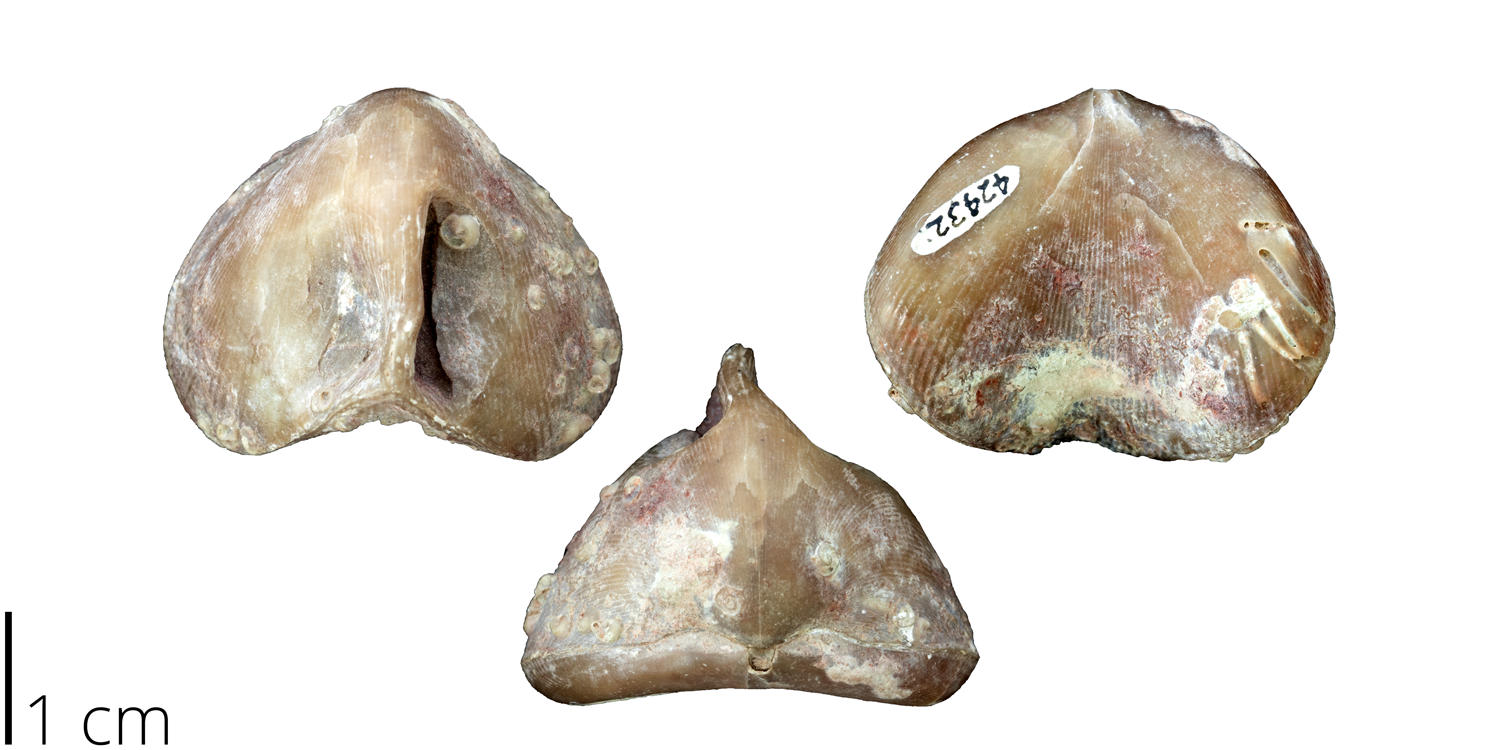
Fossil brachiopod specimen of Ladogia meyendorfi (PRI 76920). Specimen is from the collections of the Paleontological Research Institution, Ithaca, New York.
Fossil specimen of the brachiopod Tullypothyridina venustula from the Devonian Tully Limestone of New York State (PRI 70762). Specimen is from the collections of the Paleontological Research Institution, Ithaca, New York. Longest dimension of specimen is approximately 2.5 cm.
Order Spiriferida (Ordovician to Triassic)
All spirifers have a spiral-shaped brachidium, which provides the strongest lophophore support. Besides this one unifying feature, spirifers are extremely variable in their characteristics. Some of the most distinctive spirifer groups have an extended hinge line, creating wing-like shapes; many also have a strong fold/sulcus and often intense shell ribbing.
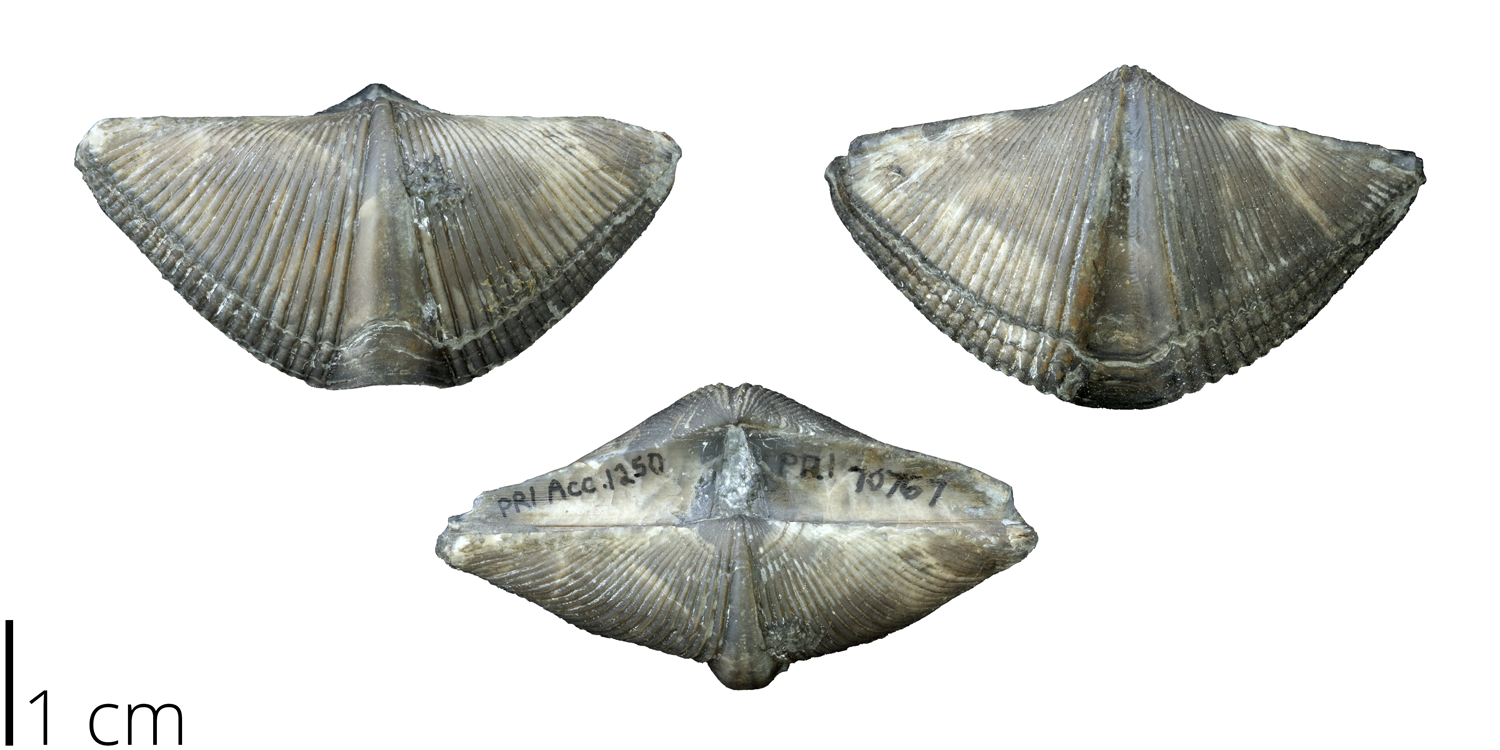
Fossil specimen of the brachiopod Mediospirifer audaculus from the Middle Devonian Moscow Formation of Livingston County, New York (PRI 70767). Specimen is from the collections of the Paleontological Research Institution, Ithaca, New York.
Fossil specimen of the brachiopod Spinocyrtia iowensis from the Devonian of Benton County, Iowa (PRI 70766). Specimen is from the collections of the Paleontological Research Institution, Ithaca, New York. Longest dimenion of specimen is approximately 7 cm.
Order Strophomenida (Ordovician to Carboniferous)
Strophomenids characteristically have a strophic (straight) hinge line, often with distinguishing dental socket patterns and no spines. Although they only existed during the Paleozoic, at times they were the most abundant of all brachiopod groups. Juvenile Strophomenata shells show a pedicle foramen, though this closed during growth, corresponding with the loss of their pedicles.
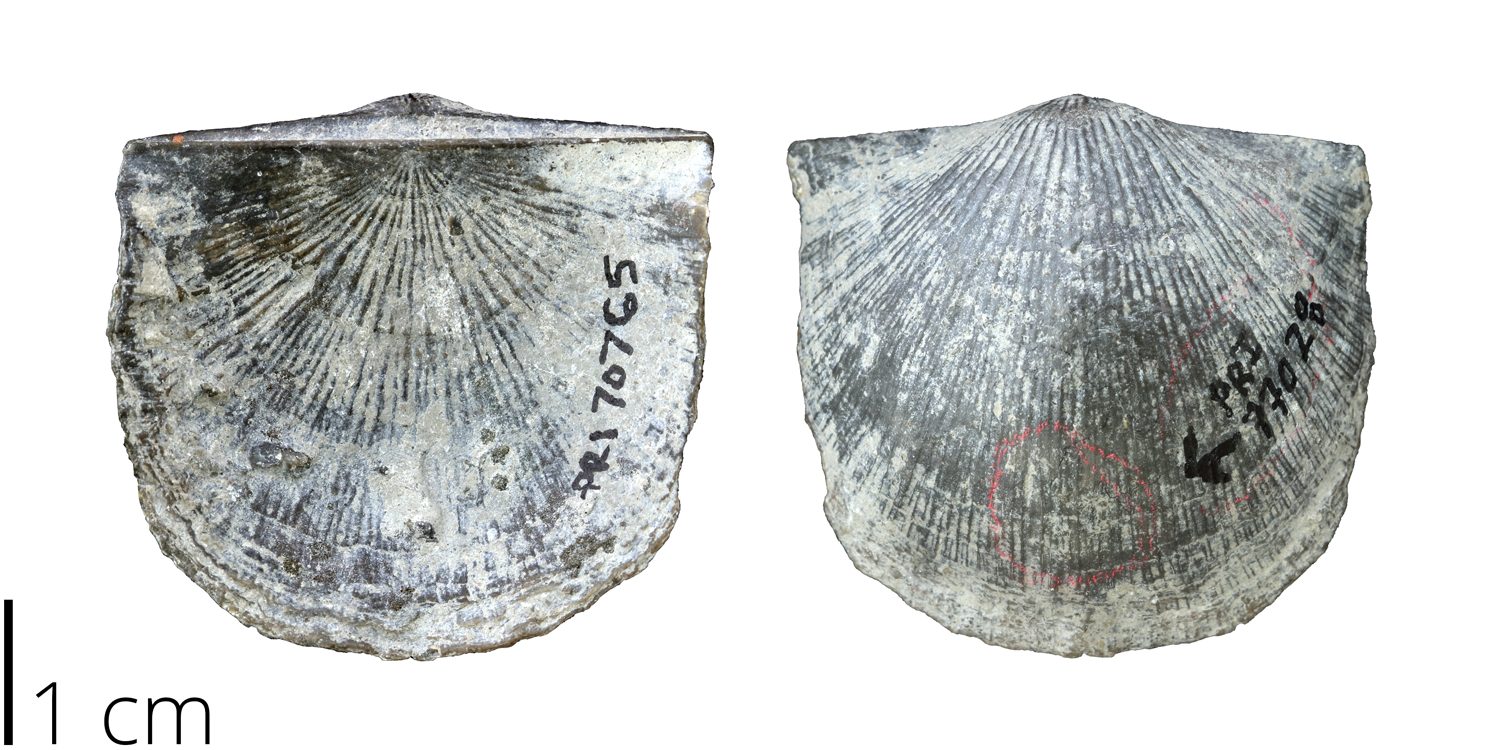
Fossil specimen of the brachiopod Strophodonta demissa from the Devonian Silica Shale of Lucas County, Ohio (PRI 70765). Specimen is from the collections of the Paleontological Research Institution, Ithaca, New York.
Fossil specimen of the brachiopod Strophodonta demissa from the Devonian Silica Shale of Lucas County, Ohio (PRI 70765). Specimen is from the collections of the Paleontological Research Institution, Ithaca, New York. Longest dimension of specimen is approxiately 4 cm.
Order Terebratulida (Devonian to Recent)
Among the brachiopods still alive today are the terebratulids. The common name for brachiopods, “lamp shells,” arose because of their smooth, bulbous shapes and their pedicle openings, which in combination cause them to resemble ancient oil lamps. They are very efficient at attaching with their pedicle, which continues to grow with shell size, a unique feature of this group. Terebratulids also have a loop-shaped brachidium and can vary in the amount of ribbing on their shells.
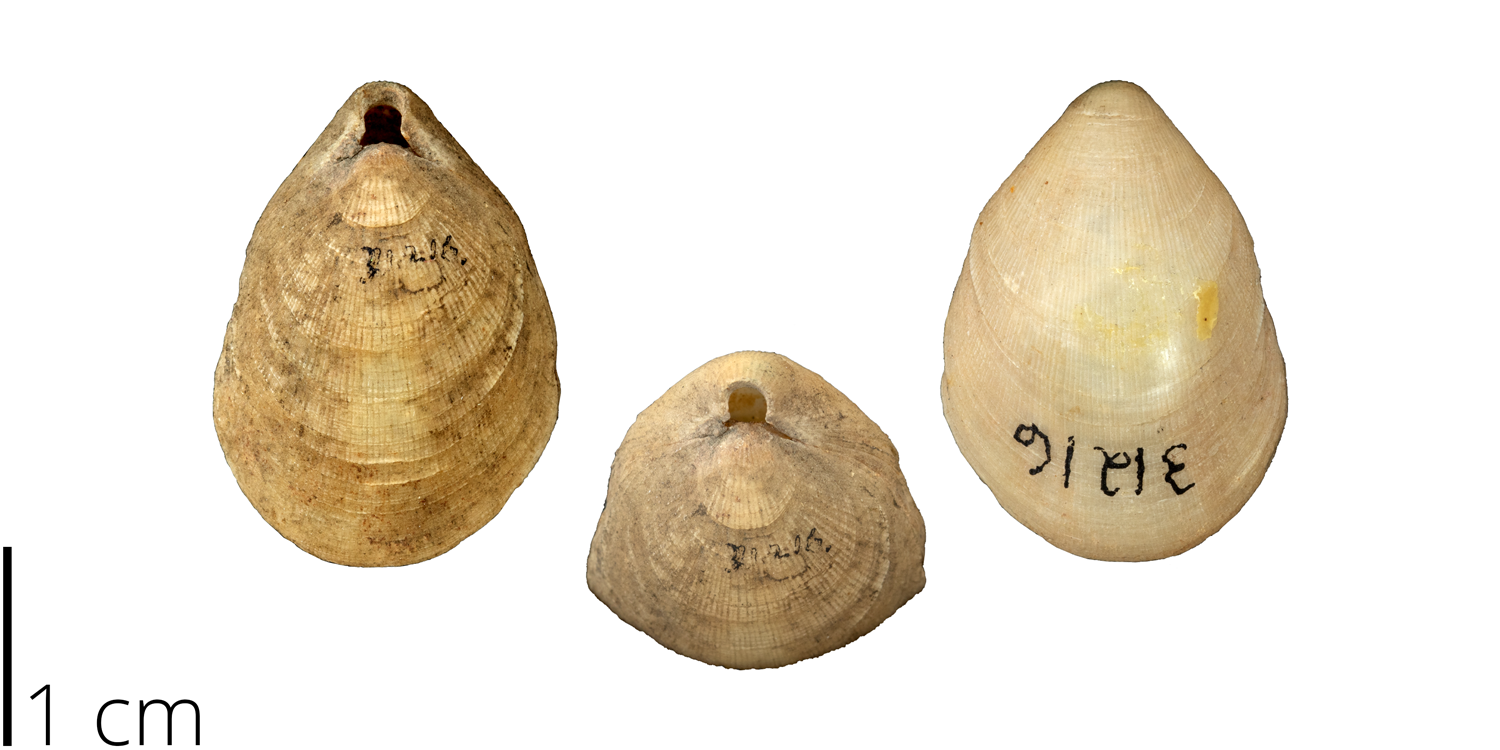
Recent brachiopod specimen of Terebratulina septentrionalis from the coast of Maine (PRI 76877). Specimen is from the collections of the Paleontological Research Institution, Ithaca, New York.
Fossil specimen of the brachiopod Magellania sp. from the Eocene La Meseta Formation of Antarctica (PRI 65576). Specimen is from the collections of the Paleontological Research Institution, Ithaca, New York. Length of specimen is approximately 4.5 cm.
Brachiopod Diversity Patterns
Brachiopods have one of the longest fossil records of any multicellular animal. Brachiopods have been the most abundant bottom-dwelling creatures for three out of five global mass extinction events, all of which occurred during the Paleozoic era. They reached the peak of their diversity during the Devonian (Emsian Stage ~407-393 million years ago). By then they had radiated into every available marine habitat and had also experienced major losses when those habitats were affected by major changes in climate.
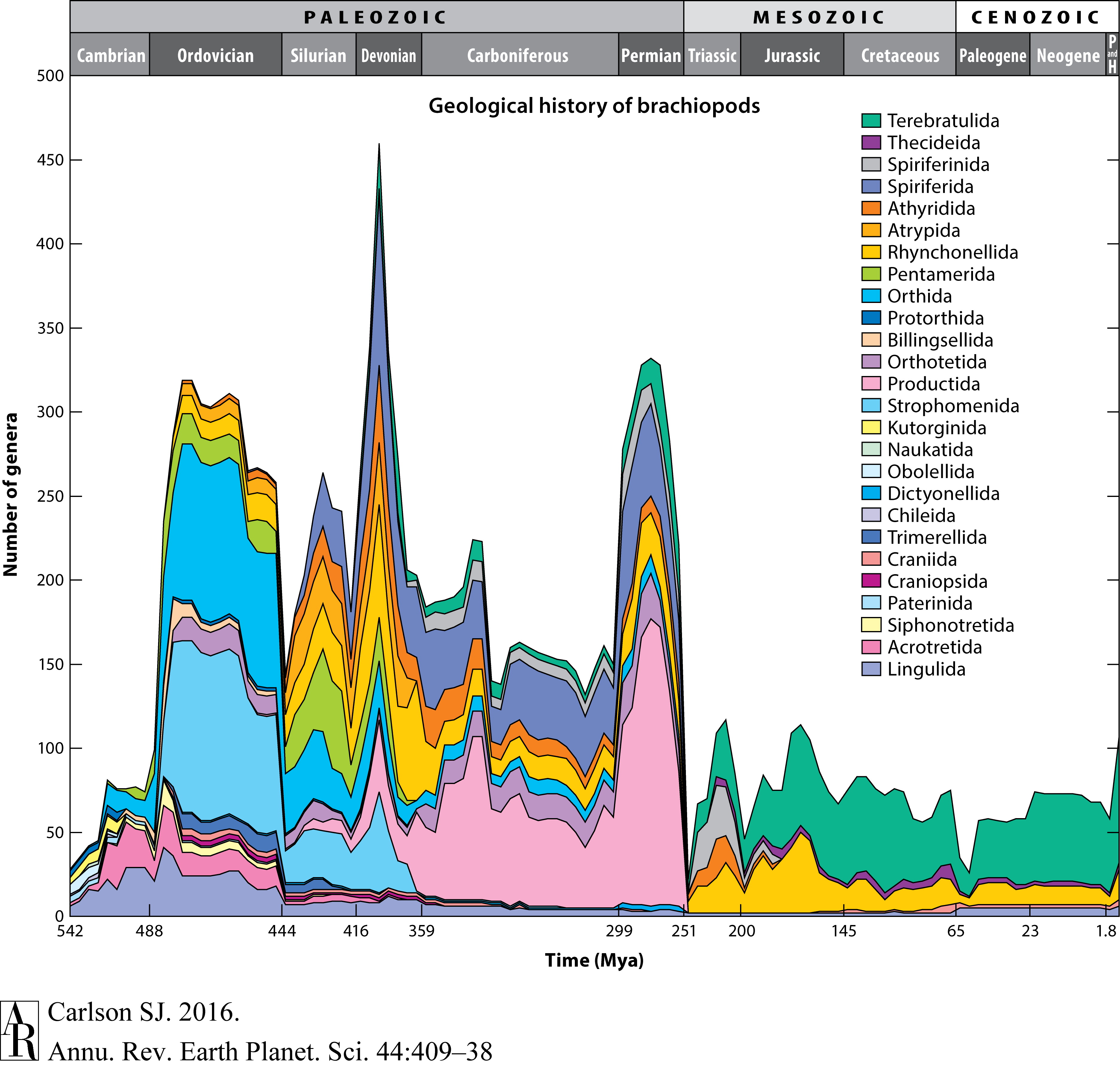
Generic diversity per geologic stage in the Phanerozoic Eon, color-coded by ordinal affiliation. Figure 8 from Carlson 2016, originally adapted from Curry & Brunton (2007), with permission from G. Curry. Work licensed under a Creative Commons Attribution 4.0 International License.
Due to their vast abundances and diversification into many species, brachiopods are useful time markers. Biostratigraphy uses the change in fossil assemblages over time to correlate rocks of the same age across regions. The best fossils for biostratigraphy are those with large geographic ranges, those that are easy to identify, and those that are very abundant. Brachiopods, ammonites, forams, bivalves, and other marine invertebrates have commonly been used for biostatigraphy.
References and further reading
Carlson, S.J. and Leighton, L.R., 2001. The Phylogeny and Classification of Rhynconelliformea, in Carlson, S.J. and Sandy, M.R. ed., Brachiopods Ancient and Modern. The Paleontological Society Papers, Volume 7:27-52.
Carlson, S.J. 2016. The Evolution of Brachiopoda. Annual Reviews of Earth and Planetary Sciences, 44:409-438.
Clarkson, E.N.K. 1998. Invertebrate Palaeontology and Evolution, fourth edition. Blackwell Publishing. 452 pp.
Heckel, E. 1904. Kunstformen der Natur, Leipzig und Wien :Verlag des Bibliographischen Instituts,1899-1904. https://doi.org/10.5962/bhl.title.102214
Holmer, L.E. 2001. Phylogeny and Classification: Linguliformea and Craniiformea, in Carlson, S.J. and Sandy, M.R. ed., Brachiopods Ancient and Modern. The Paleontological Society Papers, Volume 7:11-26.
Kazlev, M.A. 2002. Rhynchonelliformea. Accessed on August 23, 2019 through Palaeos through: http://palaeos.com/metazoa/brachiopoda/rhynchonelliformea.html
Selden, P.A. ed., Treatise on Invertebrate Paleontology, Part H, Brachiopoda Revised, Volume 6. The University of Kansas and Geological Society of America. 3226 pp.
Williams, A., Carlson, S. J., and Brunton, H.C. 2007. Rhynchonelliformea, in R.L. Kaesler ed., Treatise on Invertebrate Paleontology, Part H, Brachiopoda Revised, Volume 2. The University of Kansas and Geological Society of America. 3226 pp.
Usage

Unless otherwise indicated, the written and visual content on this page is licensed under a Creative Commons Attribution-NonCommercial-ShareAlike 4.0 International License. This page was written by Jaleigh Q. Pier. See captions of individual images for attributions. See original source material for licenses associated with video and/or 3D model content.



